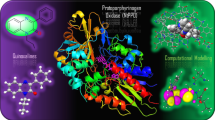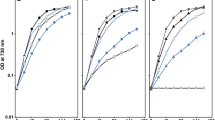Abstract
A competitive Brownian model for the interaction of ferredoxin, ferredoxin NADP+ reductase and hydrogenase has been built. In the model, molecules of three types of proteins are placed into a cubic reaction volume, where they move under Brownian and electrostatic forces created by neighboring molecules and the solution. It has been shown that the rate of ferredoxin binding with ferredoxin NADP+ reductase does not change at the pH range from 5.0 to 9.0. Thus, it may be suggested that regulation of ferredoxin NADP+ reductase activity is mediated by other processes. On the other hand, the rate of ferredoxin binding with hydrogenase in the model depends greatly on pH: if the pH value increases from 6.0 to 8.0 the rate increases by factor of three. The increase of the pH value in the stroma under illumination results in an increase of the rate of its interaction with ferredoxin, but decreases the level of protons that are the substrate for the reaction catalyzed by the protein. Thus, the rate of hydrogen production in the chloroplast stroma is low at low pH due to the reception of a small number of electrons by hydrogenase. When the pH increases, the number of electrons that are received by the enzyme from ferredoxin also increases; thus, the rate of hydrogen production increases as well.
Similar content being viewed by others
Abbreviations
- Fd:
-
ferredoxin
- FNR:
-
ferredoxin NADP+ reductase
- PS I:
-
photosystem I
- PS II:
-
photosystem II
References
H. Gaffron and J. Rubin, J. Gen. Physiol. 26 (2), 219 (1942).
R. E. Blankenship, Molecular Mechanisms of Photosynthesis (Wiley-Blackwell, Oxford, 2014).
J. T. Beatty, and J. F. Allen, Advances in Photosynthesis and Respiration. Discoveries in Photosynthesis (Springer, Dordrecht, 2006).
A. Melis and T. Happe, Plant Physiol. 127, 3740 (2001).
M. L. Ghirardi, R. K. Togasaki, and M. Seibert, Appl. Biochem. Biotech. 63, 141 (1997).
A. Melis, L. Zhang, M. Forestier, et al., Plant Physiol. 122, 127 (2000).
A. Tsygankov, S. Kousouriv, M. Siebert, and M. Ghirardi, Int. J. Hydrogen Energy 27, 1239 (2002).
T. Happe, B. Mosler, and J. D. Naber, Eur. J. Biochem. 222, 769 (1994).
L. Cournac, F. Mus, L. Bernard, et al., Int. J. Hydrogen Energy 27, 1229 (2002).
I. Yacoby, S. Pochekailov, H. Toporik, et al., Proc. Natl. Acad. Sci. U. S. A. 108 (23), 9396 (2011).
S. Juric, K. Hazler-Pilepic, A. Tomašic, et al., Plant J. 60, 783 (2009).
F. Alte, A. Stengel, J. P. Benz, et al., Proc. Natl. Acad. Sci. U. S. A. 107 (45), 19260 (2010).
P. Mulo, Biochim. Biophys. Acta 1807, 927 (2011).
M. Balsera, A. Stengel, J. Soll, and B. Bölter, BMC Evol. Biol. 7, 43 (2007).
J. P. Benz, A. Stengel, M. Lintala, et al., Plant Cell 21 (12), 3965 (2009).
Y.-H. Lee, K. Tamura, M. Maeda, et al., J. Biol. Chem. 282 (8), 5959 (2007).
I. B. Kovalenko, A. M. Abaturova, P. A. Gromov, et al., Phys. Biol. 3, 121 (2006).
I. B. Kovalenko, A. N. Diakonova, A. M. Abaturova, et al., Phys. Biol. 7, 026001 (2010).
I. B. Kovalenko, A. M. Abaturova, A. N. Diakonova, et al., Math. Model. Nat. Phenom. 6 (7), 39 (2011).
G. Yu. Riznichenko, I. B. Kovalenko, A. M. Abaturova, et al., Biophys. Rev. 2 (3), 101 (2011).
S. S. Khruschev, A. M. Abaturova, A. N. Diakonova, et al., Biophysics 60 (2), 212 (2015).
E. L. Gross and D. C. Pearson, Jr., Biophys. J. 85, 2055 (2003).
A. Spaar and V. Helms, J. Non-Cryst. Solids 352 (42), 4437 (2006).
A. Spaar, C. Dammer, R. R. Gabdoulline, et al., Biophys. J. 90, 1913 (2006).
G. Schreiber, in Computational Protein–Protein Interactions, Ed. by R. Nussinov and G. Schreiber (CRC, Boca Raton, 2009), pp. 87–108.
C. H. Chang, P. W. King, M. L. Ghirardi, and K. Kim, Biophys. J. 93 (9), 3034 (2007).
H. Long, C. H. Chang, P. W. King, et al., Biophys. J. 95 (8), 37 (2008).
O. S. Knyazeva, I. B. Kovalenko, A. M. Abaturova, et al., Biophysics 55 (2), 221 (2010).
J. K. Hurley, J. T. Hazzard, M. Martinez-Julvez, et al., Protein Sci. 8, 1614 (1999).
M. Martinez-Julvez, J. Hermoso, J. K. Hurley, et al., Biochemistry 37, 17680 (1998).
S. Kousorov, M. Siebert, and M. L. Ghirardi, Plant Cell Physiol. 44, 146 (2003).
J. M. Berg, J. L. Tymozcko, and L. Stryer, Biochemistry (Freeman, New York, 2007).
M. W. W. Adams and L. E. Mortenson, J. Biol. Chem. 259 (11), 7045 (1984).
T. Happe and J. D. Naber, Eur. J. Biochem. 214, 475 (1993).
Author information
Authors and Affiliations
Corresponding author
Additional information
Original Russian Text © A.N. Diakonova, S.S. Khruschev, I.B. Kovalenko, G.Yu. Riznichenko, A.B. Rubin, 2016, published in Biofizika, 2016, Vol. 61, No. 4, pp. 677–685.
Rights and permissions
About this article
Cite this article
Diakonova, A.N., Khruschev, S.S., Kovalenko, I.B. et al. The role of electrostatic interactions in the formation of ferredoxin–ferredoxin NADP+ reductase and ferredoxin–hydrogenase complexes. BIOPHYSICS 61, 572–579 (2016). https://doi.org/10.1134/S0006350916040060
Received:
Accepted:
Published:
Issue Date:
DOI: https://doi.org/10.1134/S0006350916040060




